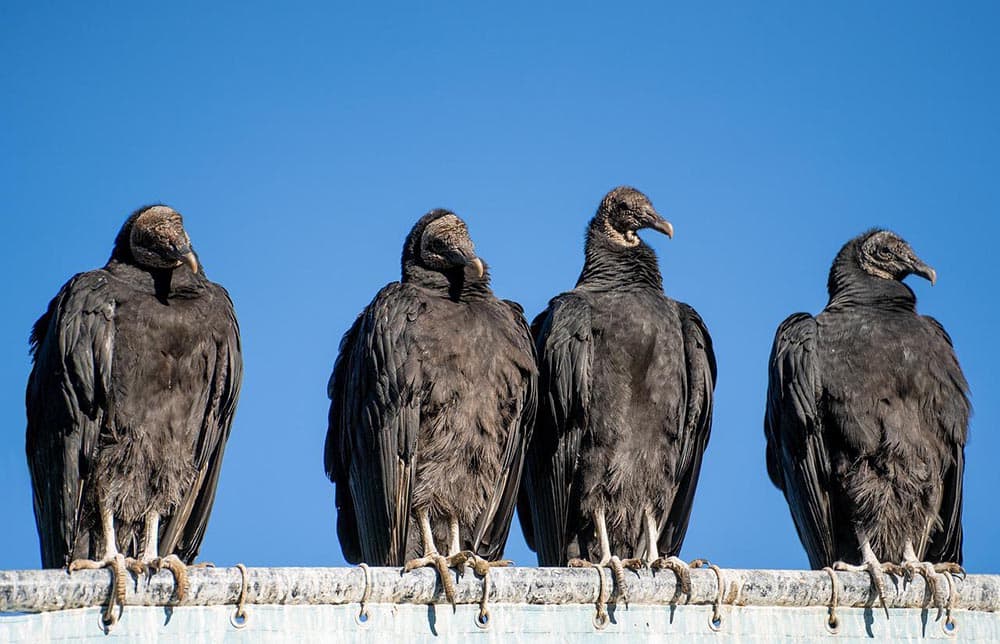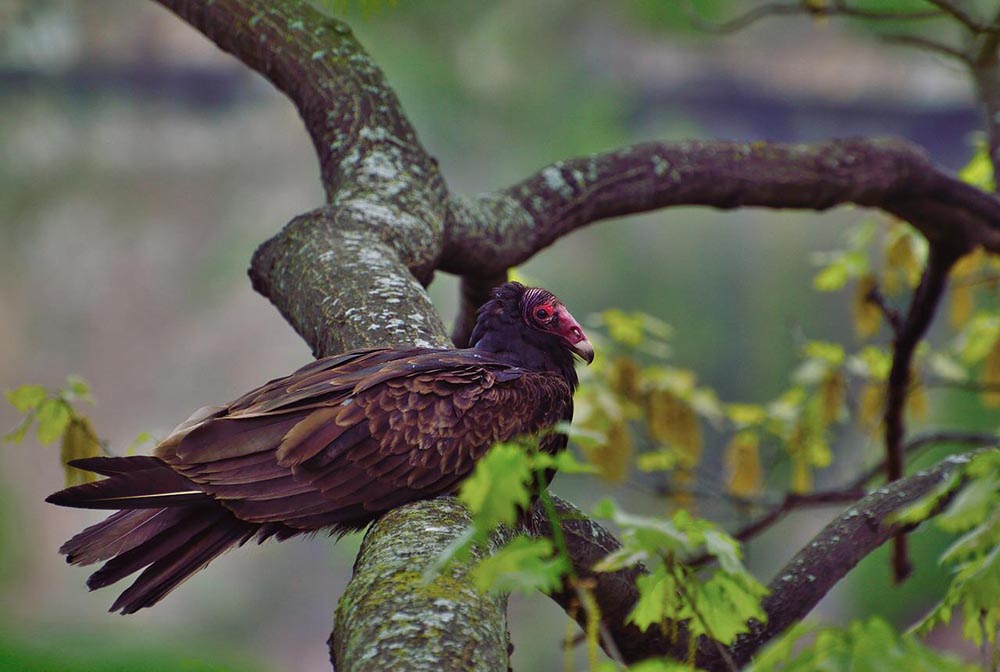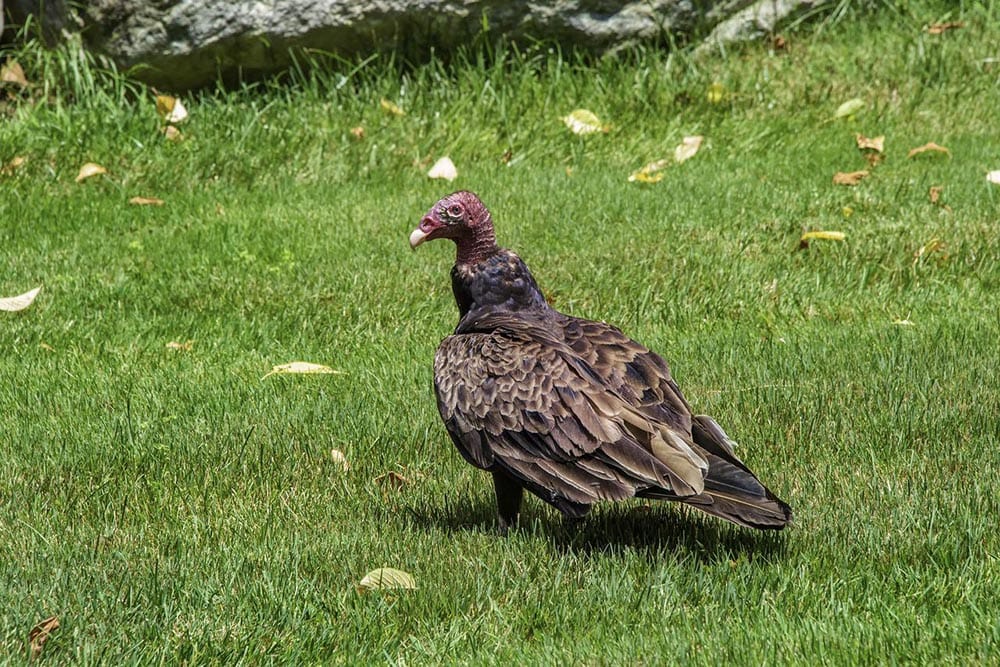Turkey Vulture: Field Guide, Pictures, Habitat & Info
Last Updated on

Turkey Vultures, or Turkey Buzzards, are scavenger birds that can be found all throughout North America. Although they don’t have the most glamorous role in their ecosystems, their presence is vital. As scavengers, they mainly feed on carrion and clear up environments of decaying carcasses that can spread various diseases.
Therefore, despite their appearance and diet, it’s worth getting to know them. Here’s all you need to know about these invaluable birds.

Quick Facts about the Turkey Vulture
| Habitat: | Open woodlands |
| Diet: | Carrion, small mammals, birds, and reptiles |
| Behavior: | Non-aggressive, scavengers |
| Nesting: | Rock crevices, caves, fallen trees, abandoned nests |
| Conservation: | Least concern |
| Scientific name: | Cathartes aura |
| Lifespan: | 10-30 years |
Turkey Vulture General Description
Turkey Vultures are large birds that can stand at 24 to 32 inches tall and weigh between 2 to 5 pounds. They can have a wingspan that falls between 63 to 72 inches.
It’s difficult to differentiate males and females because they share very similar appearances. Turkey Vultures have small, hairless, red heads and hooked beaks. Their bodies are covered in brown and black feathers, and their wings are lined with gray feathers.

Turkey Vulture Range, Habitat, Behavior, Diet & Nesting
Range
Turkey Vultures are common birds that can be found throughout the Americas. You can find the densest population of Turkey Vultures in the southern parts of the United States.
This bird is one of the most abundant species of raptors in the world, and there’s an estimated global population of 18 million Turkey Vultures.
Habitat
Turkey Vultures are adaptable and hardy, so they can live in most habitats. However, they prefer open woodlands where they can scan large fields for carrion (dead animals) while having enough trees for roosting and nesting.
You can also find them in deserts and shrublands. They don’t really inhabit dense forests because the trees can hinder their ability to take flight.
Behavior
Turkey Vultures are gregarious birds that live in groups as large as several hundreds of birds. Some groups will also be mixed with black vultures.
These large birds require a good amount of effort to take flight, but once they’re off the ground, they can glide effortlessly with minimal flapping.

Diet
The Turkey Vulture’s diet mainly consists of carrion. They have a great sense of sight and have noses that are attuned to the scent of ethyl mercaptan, which is a gas that carcasses in the beginning stage of the decaying process emit.
Turkey Vultures can also kill their prey, but this is very rare. They can hunt small mammals and reptiles, and on rare occasions, they will eat some vegetation.
Nesting
Turkey Vultures prefer to nest in rock crevices, caves, hollow trees, and thickets. They don’t really make efforts to build nests and often lay eggs on bare surfaces. Females commonly lay two eggs at a time, and it’s rarer for them to lay one or three eggs.
Both parents take turns incubating their eggs. Eggs hatch in a little over a month, and the parents will care for their chicks for about 11 weeks.

How to Find Turkey Vultures: Birdwatching Tips
Finding Turkey Vultures can be fairly easy if you’re walking through their natural habitats. Here are some things to pay attention to if you’re looking for them.
What to Listen For
It’ll be difficult to find a Turkey Vulture by listening for it because it doesn’t have a syrinx, or vocal organ. So, it can only make grunting and hissing noises.
What to Look For
Turkey Vultures like to live in big groups, so look for flocks of large black birds. They’ll also be soaring and circling around open fields looking for carcasses. So, make sure to look up for large birds that aren’t frequently flapping their wings.
When to Look
Turkey Vultures are year-round residents in the US, so they’re easy to spot at any time of the year. You may have a little more luck spotting one during breeding season when these birds come out to perform courtship displays in spring to early summer.
Some flocks can be migratory and can start to travel throughout Canada and South America as the seasons change.

Attracting Turkey Vultures to Your Backyard: Tips & Tricks
Turkey Vultures aren’t quite backyard birds as they’re very large raptors. Since their natural diet is carrion, attracting them to your backyard won’t be the most sanitary thing.
It’s best to admire these birds at a distance. They may visit if you have washed up fish at a nearby creek or an animal carcass that ends up in your yard.
Turkey Vulture Conservation: Is this Bird Threatened?
The International Union for Conservation of Nature (IUCN) lists the Turkey Vulture as Least Concern. The current population is stable and doesn’t have any particular threats that affect their population size.

Conclusion
If you’re interested in looking for Turkey Vultures, you’ll have the best luck finding them in open woodlands, shrublands, and deserts. They’re expert scavengers that glide effortlessly and expertly as they search for carrion.
While Turkey Vultures aren’t a threatened species, it’s still important to respect and protect them. They play an irreplaceable role in their ecosystems and help protect people and other wildlife from widespread diseases.
Featured Image Credit: jatocreate, Pixabay
Table of Contents
About the Author Jessica Kim
Jessica is a freelance writer who spends most of her day researching and writing a number of topics. She loves sharing helpful information that people can use to better understand their pets, nature and the world around them. When she isn't writing, you may find her walking dogs, tending to her plant babies, or drinking her nth cup of coffee.
Related Articles:
10 Types of Hummingbirds in Arkansas (With Pictures)
8 Types of Hummingbirds in Nebraska (With Pictures)
5 Types of Hummingbirds in Idaho (With Pictures)
3 Types of Hummingbirds in Mississippi (With Pictures)
8 Types of Hummingbirds in Kansas (With Pictures)
5 Types of Hummingbirds in West Virginia (With Pictures)
5 Types of Hummingbirds in Ohio (With Pictures)
Where Do Nuthatches Nest? Nuthatch Nesting Habits Explained
